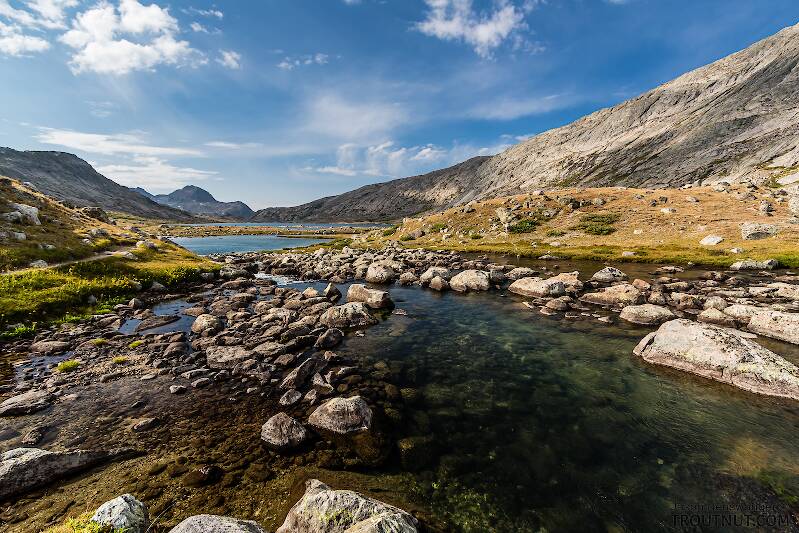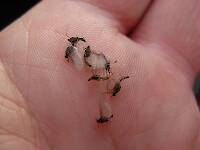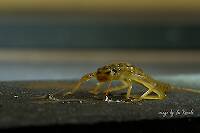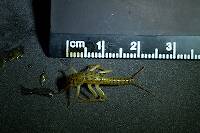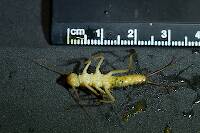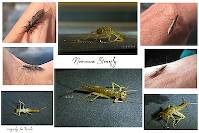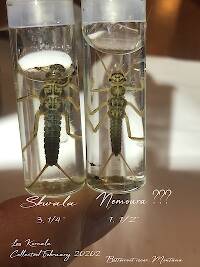
Hex Mayflies
Hexagenia limbata
The famous nocturnal Hex hatch of the Midwest (and a few other lucky locations) stirs to the surface mythically large brown trout that only touch streamers for the rest of the year.
Featured on the forum

This dun emerged from a mature nymph on my desk. Unfortunately its wings didn't perfectly dry out.

Troutnut is a project started in 2003 by salmonid ecologist Jason "Troutnut" Neuswanger to help anglers and
fly tyers unabashedly embrace the entomological side of the sport. Learn more about Troutnut or
support the project for an enhanced experience here.
Swimming
Posts: 2
Posts: 2
Swimming on Nov 2, 2012November 2nd, 2012, 10:02 am EDT
Hi,
So I'm doing an assignment on Swimming Mayfly Nymphs and I was wondering if anyone had any expert knowledge on an issue I'm having.
Recently I went to Wales and was catching Swimming Mayfly Nymphs but I have no idea what ones they were (Ameletidae, Baetidae, Isonychiidae or Siphlonuridae) and I don't have any pictures.
I was wondering if anyone knew what type of nymphs are likely to be found in Wales/UK?
If I can remember, they were about 10mm long and brown (I think).
Thanks.
So I'm doing an assignment on Swimming Mayfly Nymphs and I was wondering if anyone had any expert knowledge on an issue I'm having.
Recently I went to Wales and was catching Swimming Mayfly Nymphs but I have no idea what ones they were (Ameletidae, Baetidae, Isonychiidae or Siphlonuridae) and I don't have any pictures.
I was wondering if anyone knew what type of nymphs are likely to be found in Wales/UK?
If I can remember, they were about 10mm long and brown (I think).
Thanks.
Entoman on Nov 2, 2012November 2nd, 2012, 11:01 am EDT
Welcome to the forum, Swimming.
The bad news is that it is difficult to answer your question with reliable specificity based on the information you provided. The good news is that the number of species possible is relatively limited (unlike in NA). Sounds like you are describing Siphlonuridae nymphs, though there are a few species of UK baetid that can grow close to this size. I believe there are currently three species of Siphlonuridae recognized in Great Britain. Siphlonurus lacustris is relatively common in British lakes, ponds, and slow moving sections of some moving water. It is described as generally brownish in coloration. If the specimens you captured came from water as described above, that may be your critter. There is only a single species of ameletid and it would appear rather speckled in your hand. There are no species of Isonychiidae in the British Isles.
Another possibility is that you may have been looking at a species of leptophlebiid, which look very similar in some respects and can be found in similar habitat.
The bad news is that it is difficult to answer your question with reliable specificity based on the information you provided. The good news is that the number of species possible is relatively limited (unlike in NA). Sounds like you are describing Siphlonuridae nymphs, though there are a few species of UK baetid that can grow close to this size. I believe there are currently three species of Siphlonuridae recognized in Great Britain. Siphlonurus lacustris is relatively common in British lakes, ponds, and slow moving sections of some moving water. It is described as generally brownish in coloration. If the specimens you captured came from water as described above, that may be your critter. There is only a single species of ameletid and it would appear rather speckled in your hand. There are no species of Isonychiidae in the British Isles.
Another possibility is that you may have been looking at a species of leptophlebiid, which look very similar in some respects and can be found in similar habitat.
"It's not that I find fishing so important, it's just that I find all other endeavors of Man equally unimportant... And not nearly as much fun!" Robert Traver, Anatomy of a Fisherman
Swimming
Posts: 2
Posts: 2
Swimming on Nov 2, 2012November 2nd, 2012, 12:38 pm EDT
I wish I'd got a picture now, would have made things a lot easier. The Siphlonurus lacustris does, however, look very, very much like the Swimming Mayfly nymph I was dealing with.
And I think I can rule out leptophlebiid since their gap between the tails are definetly too wide.
Thanks a lot for the help, much appreciated!
Edit: Would you happen to know, roughly, how many types of species of Leptophlebiid there are in the UK?
And I think I can rule out leptophlebiid since their gap between the tails are definetly too wide.
Thanks a lot for the help, much appreciated!
Edit: Would you happen to know, roughly, how many types of species of Leptophlebiid there are in the UK?
Entoman on Nov 2, 2012November 2nd, 2012, 2:32 pm EDT
Would you happen to know, roughly, how many types of species of Leptophlebiid there are in the UK?
I believe there are 6 in 3 different genera.
I'm not quite sure what you mean by tail gap, but tail length is a good way to tell them apart:
a. Approx. body length or longer (usually at least 3/4) - Leptophlebiidae.
b. Much shorter than body length (usually less than 1/2) - Siphlonuridae.
Gills are also a good way. Both families have prominent ones but the former's are shaped like tuning forks and the latter's like tree leaves.
"It's not that I find fishing so important, it's just that I find all other endeavors of Man equally unimportant... And not nearly as much fun!" Robert Traver, Anatomy of a Fisherman
Quick Reply
Related Discussions
Topic
Replies
Last Reply
1
Mar 9, 2012
by Wiflyfisher
by Wiflyfisher
5
Jun 14, 2008
by Wiflyfisher
by Wiflyfisher
2
Feb 24, 2020
by Leskorcala
by Leskorcala
1
May 5, 2009
by GONZO
by GONZO

